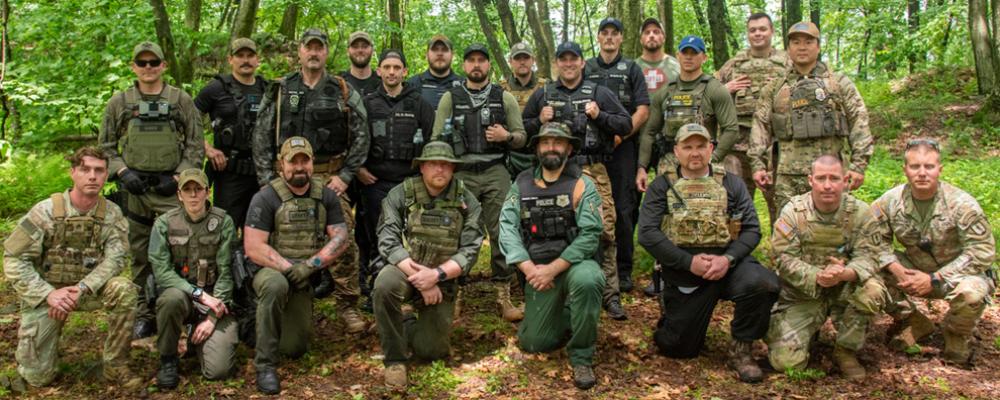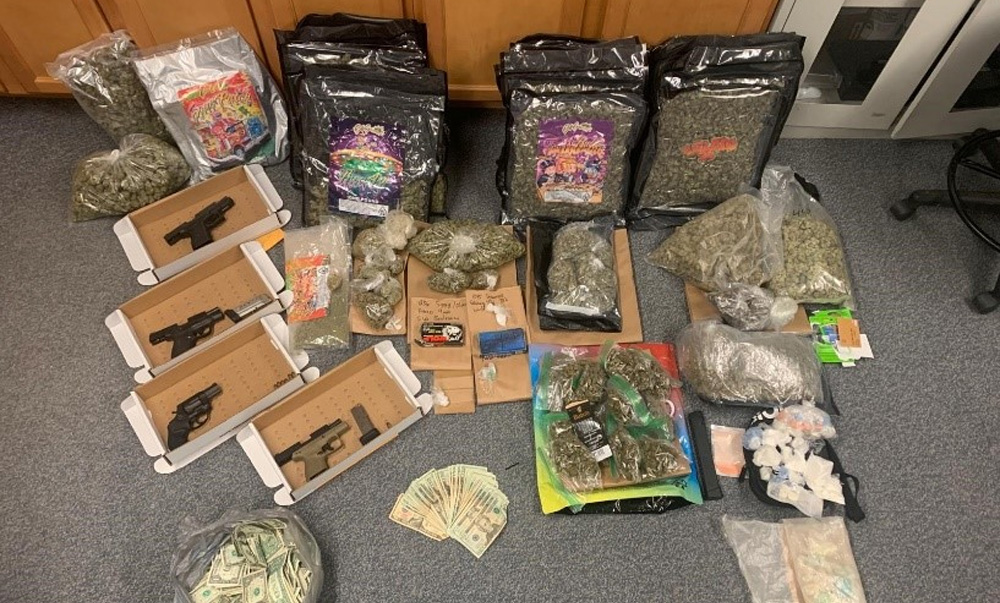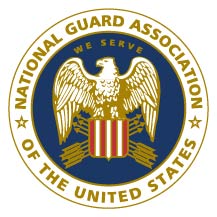
The Fight at Home
By Mark Hensch
Combating drugs is both personal and professional for Sgt. 1st Class James Adams. For more than 35 years, his work with the Pennsylvania Army National Guard and the Pennsylvania State Police has exposed him to the heartbreak of drug abuse.
“I had a cousin who became addicted to heroin,” says Adams, who currently serves full-time with the Pennsylvania Guard Counterdrug Joint Task Force as a ground reconnaissance specialist. “She ended up overdosing and died. In police work, I had a mother that overdosed and suffocated her baby when she died. She was on top of her child. They were both deceased.”
When Adams retired from the state police in 2018 as a corporal, he looked for a way to combine his military surveillance expertise and law enforcement background. He subsequently took his current position with the Pennsylvania Guard CJTF.
“I thought it would be a great career-ender for me,” he says. “I’ve always loved being in the National Guard. And it keeps me in touch with my law enforcement background, my law enforcement roots. It is a win-win for me.”
Adams assists police in Dauphin County, which is in the Central Pennsylvania and includes Harrisburg, the state capital. He monitors suspected drug activities and gathers information on production facilities, trafficking rings and criminal organizations.
His contributions have enabled the Dauphin County Drug Task Force, which is primarily made up of local law enforcement personnel, to safely execute search warrants and place trackers on cars at night, says Sgt. Shelby Day, the task force supervisor.
“If you put trackers on a car in the night, it can be extremely dangerous,” Day says. “For Jim to be a lookout — we’d be lost without him some days.”
Adams also shares his knowledge and skills with others in police work. He has taught courses on woodland tactical operations at the Northeast Counterdrug Training Center at Fort Indiantown Gap, Pennsylvania, one of five Guard counterdrug schoolhouses nationwide. They teach a wide array of courses free of charge to law enforcement personnel.
“I teach them navigation features like how to use a compass or look at land features,” Adams says. “We’d talk about camouflage techniques and moving safely and stealthily through the woods.”
Operational planning is also part of the curriculum. “We would go over a military operations order,” Adams adds. “A lot of police departments don’t have an ops plan. I teach them how to tailor it.”
Adams is one of more than 60 Guardsmen who serve on federal Title 32 orders with the Pennsylvania Guard CJTF. They support 38 law enforcement agencies with training, equipment and other support that is often in short supply to local police. They also continue to drill and participate in annual training with their units and are subject to deployment. Adams is a member of the 166th Regiment-Regional Training Institute at Fort Indiantown Gap.
Nationwide, nearly 2,500 Guardsmen (more than 1,900 Army Guard, the rest Air) are part of counterdrug programs across all 54 states, territories and the District of Columbia. State/territorial programs are tailored to local needs, with all federal expenditures subject to approval by the National Guard Bureau. Collectively, they contributed to the seizure of $10.1 billion (At a Glance, below) in illegal narcotics, currency, firearms and property and trained 68,219 students in fiscal 2023, according to the Guard’s Counterdrug Advisory Council.
While the seizures and schoolhouse training get much of the attention, the program’s drug demand reduction and outreach efforts help communities reduce their narcotics abuse through initiatives like after-school programs that push youth at risk of using drugs away from gangs and other temptations.

IN 1977, Hawaii became the first state to use the Guard to assist law enforcement with counterdrug efforts by providing helicopter transport for Operation Green Harvest, a marijuana eradication mission.
From there, other states established similar partnerships, and interest spread across the law enforcement community. The Guard counterdrug program was ultimately codified in the fiscal 1989 National Defense Authorization Act to leverage the unique capabilities of the Guard and address the growing drug problem in the United States. It now operates in every state, territory, and the District of Columbia, serving as a bridge between the military and the law enforcement community.
As the program evolved, it expanded to train law enforcement officers on region-specific threats and proven techniques to deter drug trafficking activities. The Guard counterdrug schoolhouses were established through congressional funding in 1998 and were codified into law in 2006, as part of the Office of National Drug Control Policy Reauthorization Act.
In addition to Fort Indiantown Gap, the schoolhouses are at Camp Blanding, Florida; Johnston, Iowa; Meridian, Mississippi; and Camp Murray, Washington.
Despite measurable success and demand for support, Guard counterdrug funding has remained largely static for more than two decades. The program was stuck on autopilot with an annual budget of $200 million for the program and $25 million for the schoolhouses.
Gradually, inflation and annual military pay increases ate away at the program’s personnel strength. Starting in 2018, due to stagnant funding, the Guard counterdrug program began to cut more than 100 full-time personnel per year. Instead of getting closer to funding the full authorization of 4,000 personnel nationwide, the program shrank.
Instead of adding new local partnerships, it was forced to reduce support. All while the opioid epidemic poured into American homes.
Congress’ increased reliance on stopgap budgets to temporarily fund the government has added another layer of challenges, says Lt. Col. Max Furman Jr., the Pennsylvania Guard CJTF coordinator. Under a so-called continuing resolution, the program cannot hire additional personnel or start new contracts, he says. It’s restricted to 85% of the previous fiscal year’s budget until formal appropriations are enacted.
Fiscal 2024 is an example. The president didn’t sign final defense appropriations until late March. But Furman says the program didn’t receive its full allotment of federal funding until late May, as it takes six to eight weeks for the funds to flow from the Treasury Department to the military services before ultimately ending up in program accounts. This gave states less than five months to execute a full-year budget.
Despite these challenges, the Pennsylvania Guard CJTF has attempted to keep every one of its personnel during CRs. The Pennsylvania Guard’s high mobilization rate over the past few years has led to rolling vacancies as program members deploy with their units. This has helped keep those at home employed in a full-time status, despite the limited resources.
“Pennsylvania did hire new personnel, but not to the extent we would have if funding was received earlier in the fiscal year,” Furman says. He added that the CR significantly restricted travel for the program. Missions that required overnight stays were postponed until more funding for the program was available.
Everyone has felt the pain [of fentanyl] one way or another.
—Lt. Col. Max Furman Jr., coordinator with the Pennsylvania National Guard Counterdrug Joint Task Force
FOR AREAS LIKE DAUPHIN COUNTY, Pennsylvania, grappling with the new plague on the streets, Guard support is crucial and goes the extra mile to improve public safety.
A synthetic opioid manufactured in a lab, fentanyl is 50 times stronger than heroin and 100 times stronger than morphine, and it kills. It is the leading cause of death for Americans ages 18-45, according to the federal Drug Enforcement Administration.
“Fentanyl has been a huge problem here,” says Day, the county’s drug task force supervisor. “People are overdosing on fentanyl mixed with cocaine, crack and even marijuana.”
“It touches everything,” Furman adds. “It becomes almost like a cancer. Everyone has felt the pain one way or another."
Day’s eight-member task force is responsible for all drug activity across Dauphin County, a 524.9-square-mile area with 289,234 residents. Two of the eight are Guardsmen — Adams and Sgt. Carlin Carter, a full-time counterdrug analyst. Typical of the Guard program across the 54, both are behind-the-scenes enablers, leaving the hands-on law enforcement, including arrests, to others.
“I’m a force multiplier for them,” says Carlin, a drilling member of D Company, 103rd Engineer Battalion in Horsham, Pennsylvania, who is on military leave from the Harrisburg police department. “A lot of time can go into researching people. For them not to have to do that and focus on the task at hand, it really aids the efficiency of the officers conducting these investigations.”
This is the heart of the program, leveraging the skills of the Guard for the front-line fight. Like the other CDPs across the country, Pennsylvania’s CDP leans into its ability to provide analysis support, ground and aviation surveillance, drug demand reduction and outreach skillsets to law enforcement agencies.
For analysis support, Guardsmen use skills like open-source information analysis to help federal, state, local and tribal law enforcement agencies perform duties like inspecting the postal system for drug trafficking.
The Pennsylvania Guard also employs UH-72 Lakota helicopters to perform aerial reconnaissance in support of law enforcement agencies as an added level of security while ground teams are missions.
Additionally, Pennsylvania’s CDP Guardsmen provide counterdrug transportation support. They collect and safely dispose of unused medications that might be abused using destruction sites approved by the Environmental Protection Agency.
In fiscal 2023, the Pennsylvania program had a budget of $4,833,422 to cover its 61 Guardsmen. Their work led to the seizure of drugs with a street value of $74,765,722 and the destruction of 139,513 pounds of prescription medications.
NCTC at Fort Indiantown Gap, also made its mark on counterdrug efforts during fiscal 2023. The schoolhouse trained 17,608 students, most of them from federal, state or local or community-based organizations.
Katerina Szabo, the NCTC commandant, says the schoolhouse’s courses fall into two categories. Some cover soldier skills that can come in have a place in police work, like Adams’ class on woodland tactical operations. But most focus on law enforcement taught by contracted civilian subject matter experts.
“We’re at a pinpoint between boots-on-the-ground narcotics officers and strategic- level counterdrug activities,” Szabo says.
For example, NCTC offers a 12-week class on administering polygraph examinations. Students typically complete 30-40 polygraph exams during their course work, according to Adam C. Barton, a former police officer who is now the director of NCTC’s polygraph center and its 11-member faculty.
“By the time they graduate, they are ready to hit the ground running,” Barton says. “We have about 150 years of combined polygraph experience here. If you were to go and pay for it, you’d easily have to pay anywhere from $6,000 to $10,000 just for the schooling itself.”
But not at the Guard CDP schoolhouses. The courses and on-campus lodging are free to eligible students. The schoolhouse also sends instructors around the country at no charge to law enforcement agencies.
Day has taken NCTC courses, and she says the schoolhouse’s lessons would have helped her earlier in her career. She recalls performing undercover police work without ever undergoing training on the subject during her time at a local police academy in Pennsylvania.
“I was thrown to the wolves,” she admits. “Looking back, I’m not sure how I made it out alive out of some situations. The only way these officers are getting this training is if they don’t have to pay for it. My department would not have sent me to the training if they had to pay for it.”
I'm a force multiplier.
—Sgt. Carlin Carter, counterdrug analyst with the Pennsylvania National Guard Counterdrug Joint Task Force
NGAUS AND THE GUARD COUNTERDRUG ADVISORY COUNCIL, which includes senior counterdrug personnel nationwide, began an education effort on Capitol Hill last year to create greater awareness of the program and its potential.
“In the policy world there are windows of opportunity,” says Julian Plamann, the NGAUS joint legislative manager. “With the opioid epidemic at an all-time high, now is the time to highlight what the National Guard is doing to keep drugs out of our communities.”
Telling the story worked. Fiscal 2024 defense appropriations included a record $305.8 million for the Guard counterdrug program and $30 million for the schoolhouses. The amount not only marked the program’s highest funding ever, but a $227.8 million increase over the president’s budget request.
Furman credits the well-coordinated strategic messaging and educational campaign for the funding increase. He adds that adjutants general, program Guardsmen, public affairs offices and legislative liaison offices helped carry the message across the 54. That messaging educated political stakeholders about the program’s capabilities and will lead to more partnerships that keep drugs off the streets.
Furman believes the counterdrug program helps Guardsmen make significant contributions to their communities. “This is just an extension of the domestic operations we get to do on a daily basis,” he says.
Mark Hensch is the magazine’s senior writer/editor. He can be reached at mark.hensch@ngaus.org.
TOP PHOTO: Students attending a woodland tactical operations course at the Northeast Counterdrug Training Center at Fort Indiantown Gap, Pennsylvania, gather for a group shot. (Photo courtesy of Pennsylvania National Guard)
OUR TAKE

NGAUS continues to educate and advocate for full congressional support of the National Guard Counterdrug Program. For fiscal 2025, the association seeks continued funding at the fiscal 2024 level of $305.8 million for the program and $30 million for the schools. Starting in fiscal 2026, NGAUS will advocate for an annual increase of $25 million per year until the program reaches the $460 million benchmark to reach the federally authorized level of 4,000 personnel. Once the program is fully funded, efforts will shift toward opening a sixth schoolhouse.
AT A GLANCE: National Guard Counterdrug Program
Supported seizure of the following in fiscal 2023:
$222,373,992 in Illicit U.S. Currency
$14,963,260 in Property
95,446 kilograms of Marijuana
135,936 kilograms of Cocaine
76,923 kilograms of Methamphetamines
29,372 kilograms of Heroin
13,799 kilograms of Synthetic Opioids
Total Estimated Street Value: $10.1 billion
Source: National Guard Counterdrug Advisory Council



